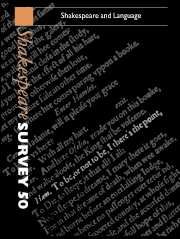Book contents
- Frontmatter
- Shakespeare’s Language and the Language of Shakespeare’s Time
- ‘I’ll plague thee for that word’: Language, Performance, and Communicable Disease
- The Language of the Spectator
- Marlowe’s Edward II: Penetrating Language in Shakespeare’s Richard II
- Hamlet’s Ear
- Secrecy and Gossip in Twelfth Night
- Shakespeare Rewriting Ovid: Olivia’s Interview with Viola and the Narcissus Myth
- ‘Voice Potential’: Language and Symbolic Capital in Othello
- Household Words: Macbeth and the Failure of Spectacle
- Erring and Straying Like Lost Sheep: The Winter’s Tale and The Comedy of Errors
- The ‘Shakespearian Gap’ in French
- Reading the Early Modern Text
- Shakespeare and the Metamorphosis of the Pentameter
- Rereading Illustrations of the English Stage
- Nietzsche’s Hamlet
- ‘Strange and woonderfull syghts’: The Tempest and the Discourses of Monstrosity
- Shakespeare Performances in England, 1996
- Professional Shakespeare Productions in the British Isles, January–December 1995
- 1 Critical Studies
- 2 Shakespeare’s Life, Times, and Stage
- 3 Editions and Textual Studies
- Books Received
- Index
Reading the Early Modern Text
Published online by Cambridge University Press: 28 March 2007
- Frontmatter
- Shakespeare’s Language and the Language of Shakespeare’s Time
- ‘I’ll plague thee for that word’: Language, Performance, and Communicable Disease
- The Language of the Spectator
- Marlowe’s Edward II: Penetrating Language in Shakespeare’s Richard II
- Hamlet’s Ear
- Secrecy and Gossip in Twelfth Night
- Shakespeare Rewriting Ovid: Olivia’s Interview with Viola and the Narcissus Myth
- ‘Voice Potential’: Language and Symbolic Capital in Othello
- Household Words: Macbeth and the Failure of Spectacle
- Erring and Straying Like Lost Sheep: The Winter’s Tale and The Comedy of Errors
- The ‘Shakespearian Gap’ in French
- Reading the Early Modern Text
- Shakespeare and the Metamorphosis of the Pentameter
- Rereading Illustrations of the English Stage
- Nietzsche’s Hamlet
- ‘Strange and woonderfull syghts’: The Tempest and the Discourses of Monstrosity
- Shakespeare Performances in England, 1996
- Professional Shakespeare Productions in the British Isles, January–December 1995
- 1 Critical Studies
- 2 Shakespeare’s Life, Times, and Stage
- 3 Editions and Textual Studies
- Books Received
- Index
Summary
Never again will a single story be told as though it were the only one.
John BergerIn what follows I examine multiple jurisdictions first in the context of Shakespeare's language, both literary and material, and then in early modern social formations. My sense is that language and social formation form a continuum. But at the end I leave the question open to invite others to intervene.
In the 1984 MLA session on Shakespeare and the New Criticism the late Joel Fineman, while claiming to distance himself both from Foucauldian and Derridean modes of analysis, staked out territory that he would later develop at large in The Perjured Eye. His stated intention in this initial reconnaissance missile was to show the ways in which, and I quote Fineman, 'Shakespearean subjectivity governs, for strictly formal reasons, the literature of personality from its beginning in the early modern period through its end in twentieth-century Modernism.' This subjectivity he saw as inhering in the larger rhetorical strategies of Shakespeare's two narrative poems as well as in his sonnets, and also in the particular detail of the individual rhetorical figures that make up the poems' collective style. I am not interested here in Shakespearian subjectivity either in its early modern or postmodern configurations, though I will return near the end of this paper to the question of character as suggested by the material texts. My initial concern is rather with the formal reasons Fineman selects and, in particular, his extended analysis of a rhetorical figure that occurs at the beginning of Shakespeare's Rape of Lucrece.
- Type
- Chapter
- Information
- Shakespeare Survey , pp. 135 - 146Publisher: Cambridge University PressPrint publication year: 1997



